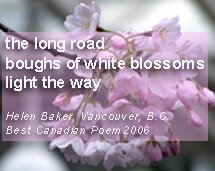The 2007 Details
Celebrate the beauty of cherry blossoms. Create a haiku for the 2007 Vancouver Cherry Blossom Festival!
Special thanks to all the poets around the world for submitting a haiku to the Haiku Invitational 2007. Watch the website for the announcement of winners next month.

All poets, new or experienced, from British Columbia and around the world are invited to submit one unpublished haiku in English inspired by the cherry blossom. The submission deadline is January 11, 2007.
The festival is working towards creating a permanent Haiku Memorial stone for Burrard SkyTrain Station in downtown Vancouver where the first cherry blossom festival was launched to honor 2006 and 2007 winning haiku. Christopher Gaze, artistic director of Bard on the Beach will perform these and selected haiku at the festival's kick-off event, Cherry Jam Downtown scheduled for March 2007.
Millions will also enjoy reading the winning haiku displayed on banners inside 500 Coast Mountain buses and SkyTrain cars throughout the festival during March and April. Other selected haiku will also be featured on this website and at Festival events.
Learn more about the haiku form, or read the Top 2006 Festival Haiku to start. Then submit your haiku.
Download the PDF

A haiku is the expression of a temporary enlightenment in which we see into the life of things.
R.H. Blyth
About Haiku
What is a haiku?
A haiku is a poem that captures a scene or experience in just a few words, suggesting the depth and intensity of the moment. Haiku use concrete images to imply the poets emotion without stating it.
Who writes haiku?
People of all ages from around the world write haiku. For some it is recreation, for some it is a spiritual practice, and for others it is a literary discipline.
How can I get started?
The best way is to read as many haiku as you can. Start with the 2006 Vancouver Cherry Blossom Festival Top Selected haiku.
Refer to one of the websites listed at the bottom of this column for some great online resources. At the library or bookstore, look for Cor van den Heuvels The Haiku Anthology with hundreds of excellent haiku in English. Robert Hasss Essential Haiku features poems by three of Japans greatest haiku masters, Basho, Buson, and Issa.
Several how to write haiku books are available; William J. Higginsons Haiku Handbook and Lee Gurgas Haiku: A Poets Guide are among the best.
What are some of the basics of writing haiku?
Haiku differ from other types of poems. Haiku use plain language and sensory images. They avoid using abstract or conceptual words, similes, metaphors, rhyme, or language that is too poetic. If you are writing a general statement about life without evoking any emotions through sights, sounds, smells, or tastes, you are likely writing something other than a haiku.
In a haiku, every word must count. If you can omit a word or phrase without losing the thread of your meaning or interrupting the natural flow of language, do so.
I thought that a haiku had to contain 17 syllables. Why dont Western haiku follow a 5-7-5 syllable count?
In Japan, the haiku is traditionally written in a single vertical line with sound symbols arranged in a 5-7-5 pattern. However, as Japanese words are often longer than English words, literal translations end up as English poems with fewer than 17 syllables.
A few haiku poets writing in English do follow the 5-7-5 pattern with wonderful results, but most poets view the haiku as a poem in three lines of 17 or fewer syllables.
What else should I know about the form of a haiku?
Most haiku contain a kigo, a word or short phrase that places the poem in a season of the year. For example, if you use the word daffodil, the reader will know you are describing a scene in spring. The kigo links the haiku to the deeper rhythms of nature.
In addition, most haiku create the English equivalent of the kireji, which in Japanese haiku is a word that cuts the poem into two parts. In the West, poets use punctuation marks (dashes, commas, or colons) or spacing (extra spaces between words or line breaks) to divide their poem. The purpose of having two parts is to create tension or an unstated relationship between two images.
By reading good haiku, youll see how kigo and kireji work.
Are there any helpful haiku organizations?
Yes. Haiku Canada has members across the country and around the world. Pacifi-kana represents Haiku Canada in British Columbia and the Yukon, Northwest, and Nunavut Territories. The Haiku Society of America welcomes members from other countries. Haiku Northwest in Washington State is the closest US regional group to Vancouver.
Visit the following websites to learn more about these and other organizations:



